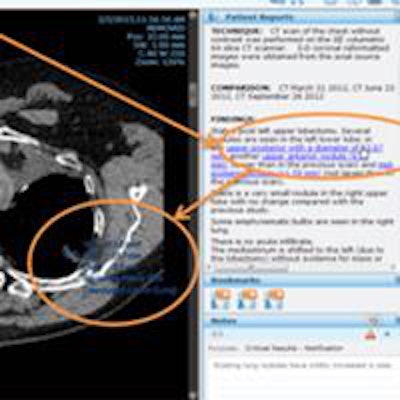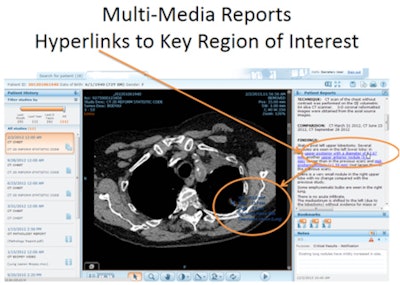
Not only do referring physicians prefer interactive multimedia radiology reports over traditional text-based reports, they are more inclined to refer their patients to facilities that provide them, according to a poster presentation at last week's RSNA 2014 meeting in Chicago.
A team led by Dr. Gelareh Sadigh of Emory University surveyed approximately 200 physicians and found that nearly 80% believed multimedia reports -- which provide interactive features such as hyperlinks to access key regions of interest, bookmarks for relevant prior images, and quantitative information in tables and graphs -- would be an improvement over traditional radiology reports. Even more important, nearly 80% would be more likely to refer their patients to the practices that provide those types of reports.
"That was the real 'wow' for me, seeing how it would potentially change referring physician referral behavior," senior author Dr. Richard Duszak Jr. told AuntMinnie.com.
Richer reports
Traditional radiology reports are text-based and may not include quantitative or image data. In contrast, multimedia-enhanced radiology reports include image data and features such as hyperlinks to key regions of interest, according to the researchers from Emory, the Harvey L. Neiman Health Policy Institute, RIS/PACS vendor Carestream Health, and consulting firm IDR Medical.
In their study, the researchers sought to assess the value of Carestream's multimedia-enhanced radiology report capabilities by performing an online survey of a pool of physicians that Carestream had previously utilized for research purposes. The participants included 50 pulmonologists, 50 medical oncologists, 50 radiation oncologists, and 50 neurosurgeons. All had more than two years of experience after residency/fellowship training and personally referred 10 or more patients per week to a radiology department.
The researchers presented a series of slides to the physicians that showed a traditional radiology report and some screenshots of a multimedia-enhanced report. The presentation also included descriptions of how the hyperlinks work.
The participants were then asked 22 questions about their demographics, the radiology report format they currently receive, and the value of multimedia reports as an alternative reporting mechanism, according to the researchers.
Satisfied, but wanting more
The final survey group consisted of 194 responding physicians; 84% were male and 48% were from academic medical centers. While 78% were satisfied with the current format of their radiology reports, 79% said they believe the new multimedia reports would represent an improvement.
The following were cited as advantages of multimedia reports:
- Improved understanding of radiology findings by correlating images with text reports: 86%
- Easier access to images while monitoring progression of a disease/condition: 79%
- Time saved trying to understand findings without supporting imaging: 66%
- Easier access to images while planning treatment: 64%
 With multimedia reports, referring physicians can access key regions of interest via hyperlinks, for example. Image courtesy of Dr. Richard Duszak Jr.
With multimedia reports, referring physicians can access key regions of interest via hyperlinks, for example. Image courtesy of Dr. Richard Duszak Jr.As for disadvantages, 28% of the surveyed physicians expressed concern about adopting these multimedia reports. For example, they were concerned the reports would be too time-intensive (15%) and that their clinical workflow does not lend itself to viewing reports in such a fashion (11%).
Nonetheless, 79% of the surveyed physicians reported an increased likelihood of referring patients to facilities that offer these multimedia radiology reports, and they would also recommend that their peers use them, according to the group.
Duszak noted that Emory is not a Carestream PACS customer and therefore doesn't use these multimedia reports in practice.
Views on imaging
The research project is one of several Duszak has been working on to explore how referring physicians view imaging.
"One of the areas that is of particular interest to me, as somebody who's very interested in physician payment systems, is how radiologists will start responding to this paradigm shift of going from volume-based payment to value-based payment," he said. "Conceptually [this shift] sounds great; let's not just crank out the widgets, let's take care of patients and maximize their outcomes and maximize their experience."
However, in reality, that concept is a little more complicated for radiologists, he said. While radiologists do have an opportunity to engage more directly with patients, the vast majority of radiologists communicate more often with referring physicians.
"Ultimately, they are our customer," Duszak said. "The challenge in going from volume to value is not what we as radiologists think is valuable, but what referring physicians think is valuable."




















